We will take a short break from examining the REMS Scale of Woo, mostly because I don’t have the next post ready to go. We will resume our regularly scheduled blatherings tomorrow.
Thank you for your patience.
Now we have our two axes:
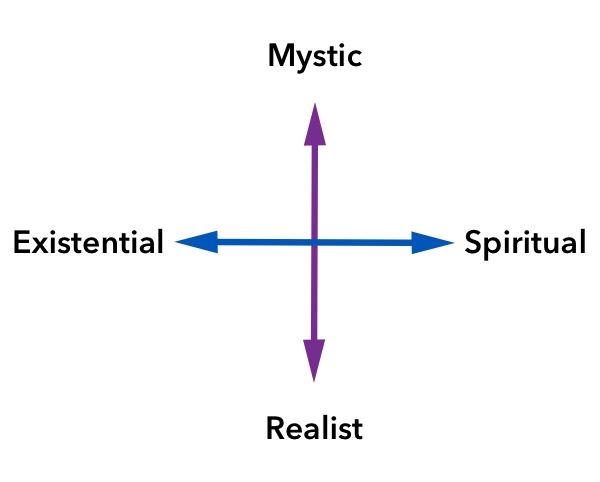
The EXISTENTIAL <—> SPIRITUAL axis defines the individual’s inclination to grant woo an independent reality, the approach to woo. The REALIST <—> MYSTIC scale defines the individual’s willingness to experience or interpret an event as woo, or the response to woo.
You might suppose that all Realists would be Existential and all Mystics would be Spiritual, but that is—oddly—not the case. Although we will first examine the two obvious combinations, my four subjects actually represent the four possible combinations of the two axes.
Let us suppose that our four subjects, having gone to the wellspring of American New Age Woo, Sedona, AZ, have decided to pop in to the Center for the New Age and see what kind of woo they can experience.[1] The CNA offers a rather complete range of woo: besides the store full of crystals, candles, occult objects, books, and tarot decks, they have a large staff of trained specialists who can give you tarot readings, crystal work, aura readings, past life regressions, chakra balancing, and other psychic guidance.
At the main counter, you can flip through a notebook with the vitae of the psychics on duty and book your session there. Given our two scales of approach and response, we can expect different reactions to the situation.
The Existential Realist neither thinks woo is real nor is willing to acknowledge that he has experienced any such thing. In the CNA, he may browse the shelves and may even find a book that interests him, but the crystals are just pretty rocks and the candles smell.
If he’s an asshole, he may openly disparage the shop and its denizens. If he’s nicer than that, he may decline to book a session or evade the topic altogether. If he decides to enter into the spirit of the thing, he will politely endure the ministrations of the chakra balancer, but he will feel nothing and will chalk it all up to being a good sport.
The Spiritual Mystic, on the other hand, feels acutely the spiritual nature of the place. In fact, he may be overwhelmed by it, or react negatively to this particular location’s vibe and seek his woo experience some place more simpatico.
If he decides to book a session, he will select a practitioner exactly as the staff has instructed—by using his intuition—poring over each page to see if he feels a connection with the man or woman in the picture. He will listen earnestly to advice from the staff about which service would be best to meet his psychic needs.
Once in the session, he will feel the energy of the room, the practitioner, and the process. The energy will inform his experience, and he will come away from the session feeling very different than when he went in.
Here’s where our model flies in the face of logic but is actually a useful descriptive tool: The Existential Mystic does not think there is anything out there that is worth the name of woo. He can pick up any number of quartz crystals without feeling a single tingle.
However, if in his chakra balancing he sees specific images or feels a warmth/coldness/whatever in one of the chakras, then he is more than willing to acknowledge that he cannot—or does not need to—explain it away. He evaluates it as ineffable and includes it in his spiritual makeup.
This one is even odder than the Existential Mystic. The Spiritual Realist does believe in God/auras/the Force, but is apt to deny any manifestation of it unless presented with overwhelming evidence.
At the CNA, he glosses over all the items for sale as being irrelevant trinkets, but he does take the time to choose a psychic and book a session. He represses giggles during the chakra balancing, but then turns around and books an additional reading from the psychic, which he finds both impressively accurate and helpful. (He nonetheless inquires about the man’s credentials.) After the reading, he may feel the need to buy a crystal or two.
Faced with woo:
—————
[1] Although the four subjects are real people, I am fictionalizing their responses to the experience. I do not presume to know the originals’ innermost thoughts, nor do I claim that how I portray their responses is in any way an accurate representation of them. To further muddy the waters, I am portraying all four subjects as male.
Yesterday I proposed a scale to delineate a person’s approach to woo, i.e., their willingness to grant the woo in question an independent reality, howsoever they defined it: New Age energy, the Force, mana, God. It’s important to realize that this mindset (Existential <—> Spiritual) is the subject’s “resting state,” in the absence of any particular woo encounter.
But after woo is encountered, what is the subject’s response? What is his willingness to experience or interpret an event as woo?
Before we define the scale, the question arises: can a person who is more Existential than not actually experience woo? I think they can, and I don’t think we can say it’s any less “real woo” even if we take into account that bane of social researchers, suggestibility.[1] As I said in yesterday’s post, we should not discount an inner reality just because it cannot be measured by calipers.[2]
The Realist’s response to an encounter with woo is, in a nutshell, “Bah! Humbug!” (For those who may not have ever thought about what this phrase actually means, humbug is quackery or bullshit.)
The Realist may be completely gobsmacked by a tarot reading or prayer session, but he is apt to put it all down to physiology or coincidence or, of course, suggestibility. He takes a good hard look at Marley’s face and sees that it is, after all, just a door knocker.
Once again, this is not meant to be derogatory, merely descriptive of one possible response to woo. Given the elastic reality of woo, it’s only smart to think that the disturbance in the Force which you felt may be an undigested bit of beef or a fragment of underdone potato.[3]
On the other end of the response axis is the Mystic.
The Mystic will emerge from an encounter convinced that he has encountered woo of some sort: his chakras are now balanced, the crystal has opened his Third Eye, God has spoken to him. Again, the question of “real woo” need not concern us at this point, only that the Mystic has interpreted his experience as woo.
Now we have our second axis:
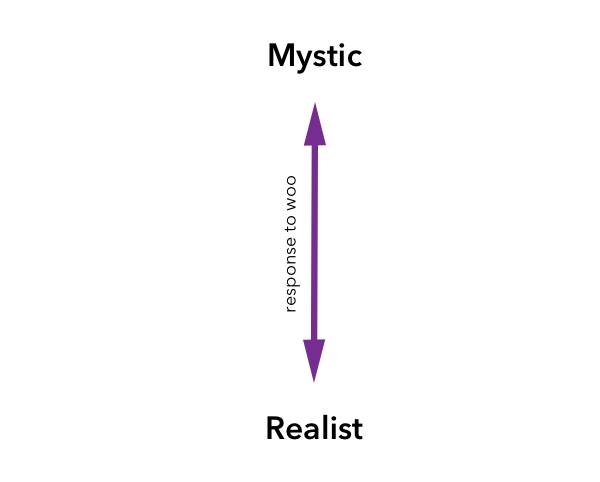
This scale is even more slippery than the Approach axis, because people definitely have different expectations and tolerances for all the various woos of the world. The same person who offers to pray for your illness may scoff at Reiki. Someone who loves a good tarot reading may look askance at a good smudging (although to be sure that is less likely than the first scenario). Those who speak in tongues do not practice Feng Shui.
As S. Elizabeth Bird found in her study of tabloid newspapers, people will often believe one kind of woo while rejecting all the others. (In For Enquiring Minds, for example, those who read The Weekly World News at all seriously were apt to do so for one topic. The Elvis believers thought the aliens were bogus, and vice versa.)
But even if we need to apply the scale on a case-by-case basis, it still allows us a descriptive, and I hope useful, framework.
—————
[1] Thanks to Marc Honea for keeping this concept in the forefront of my mind.
[2] I’ll take up the issue of “real woo” in another post.
[3] Yes, I know that by using Ebenezer Scrooge as my exemplar makes it look as if I’m disparaging our Realists as merely unconverted Mystics, but I am not. Besides, Scrooge’s “humbug” turned out to be real enough, wasn’t it?
Yesterday we looked—vaguely—at what we meant by the woo experience: that feeling that there is an “energy” other than/bigger than/inclusive of us, manifesting itself in things like chakras, crystals, auras, magick, and religion. Today I want to look at the first of the two axes of the REMS scale, that of approach.
By approach, I mean the individual’s inclination to grant woo an independent reality. On the far end we have those who have their horoscopes cast and consult with their psychic adviser on a regular basis. They sleep with crystals under their pillow. They post photos of a beautiful sunset on Facebook and give God the credit. They never step on a crack so as to avoid breaking their mother’s back.
These are our Spiritual members.
It is important to me to make clear that I am not denigrating those who are on the Spiritual end of the approach axis. On the contrary, their spirits are open to the unknown, to the infinite, and I do not believe that is without value. When I equate chakra balancers with the devout of any religion, it is merely to observe that both are willing to grant an external reality to their respective woos, an external reality that cannot be measured by any scientific instrument. Yes, it is faith.
On the other end of the approach axis, therefore, we find the Existential members. These people do not “believe” in anything that cannot be measured. They are the coiners of the term “woo” to deride the other end of the axis. They are disinclined to grant any external reality to the woo experience: all of your woo is inside your head. Existence precedes essence.
And let me say here, again, that this is a perfectly cromulent way to approach woo. I would caution the Existentials among us, though, that denying woo an external reality does not necessarily mean denying it an inner reality. It’s all in your head? That is a kind of reality after all, and a wise Existential learns to accommodate that idea. (But that is more for the discussion on Response.)
So now we have one of our two axes:
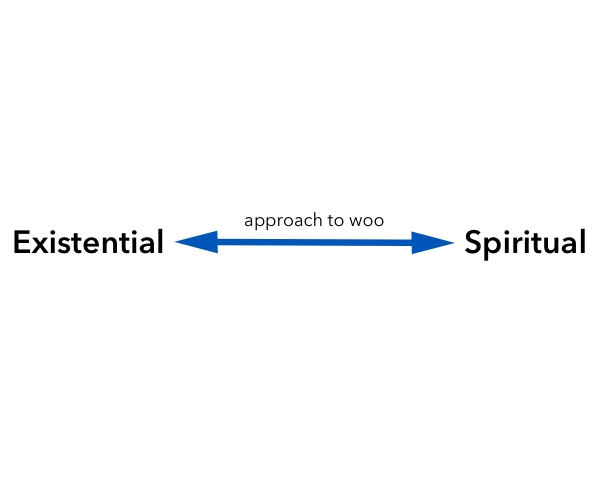
Like most axes of this nature, most people would not find themselves on the absolute end of either side of the scale. If we consider it in purely religious terms, people will range from atheist through agnostic to devout.
This, by the way, provides us with the E and the S in our REMS Scale.
At long last, the long-awaited explication of my world-changing examination of the Woo Experience, which, for lack of a catchier name, we shall call the Lyles REMS Scale.
First of all, we need to define what we mean by the Woo Experience, and for that there is no better place than the Skeptic’s Dictionary: “concerned with emotions, mysticism, or spiritualism; other than rational or scientific; mysterious; new agey.” This and other fine sites are more likely to use the term woo-woo, but for our purposes one woo is enough.
The issue arose during our recent trip to Arizona, to Sedona specifically, where we sought out the Woo Experience via visits to vortexes,[1] aura readings, chakra balancing, and crystals. Each of these—and there was more—involves some kind of mystical “energy” that is detectable only by those who are attuned to it. Certainly no scientific instruments have ever been able to verify its existence.
And yet…
Here’s where the interesting part lies. There are very few among us who have not felt as if there might be some kind of validity to the woo.[2] Call it auras, call it The Force, call it Magick, call it the Void, call it God—or the Goddess—but nearly every one of us can confess to having felt something like it at some point.
So what are we to make of this universal experience that has absolutely no scientific validation?
It began to interest me that in our small group there seemed to be different approaches and different responses to the woo, and I began to think more seriously about the proposition.
For this discussion, I choose to rename the four participants Subjects 1-4. (Full disclosure: I am Subject 3.) The entire vacation to Arizona was initiated by Subject 4’s desire to go experience the “thin places” in Sedona, i.e., the vortexes. Even as the trip expanded to include the Grand Canyon and points in between, we all came to agree that if we were going to Sedona, we would seek out and immerse ourselves in the woo. Just go with it, experience it, and withhold evaluation until we were done with it.
Because what’s the fun of having your chakras balanced if you’re not going to give it the benefit of the doubt? Let’s face it, if the whole thing was just a placebo, then you’d get no benefit if you didn’t commit to it. And if it were real, you wouldn’t want to short-circuit it by resisting it.
The wooists make all kinds of outrageous claims for their woo that bring universal scorn and condemnation upon them, and rightfully so when those claims involve medical issues and large bank transfers.
But for the true believers—and those of us just looking for fun or interest—what is the appeal? I think most if not all of it is because we humans desire order. We see patterns where there are none. We want resolution.
Are we at some level unhappy? (Spoiler alert: yes, because we are human.) Shouldn’t there be some way to fix that? (Emphasis on should.) Isn’t there something, after all, bigger than us, of which we are a part? (…)
And so we seek to identify causes outside ourselves that can help us gain peace, comfort, and unity. Woo, I believe, is one of the ways in which we do that: crystals, magick, god.
—————
[1] N.B.: not vortices, so stop your kibbitzing
[2] …which I will now stop capitalizing
I have not reported on my experience at Alchemy 2015: Amalgamation because I’ve been busy getting A Christmas Carol on its feet. Not only that, but as you will guess, it took me two weeks after the burn to get the 3 Old Men’s stuff all cleaned, dried, and packed away.
Disclaimer: Many of these photos were taken by other people, and to my shame I did not make any notes for crediting them in this post. If I can go back and find them, I’ll correct that. If you’re reading this and recognize one of yours, let me know and I’ll credit you.
Also disclaimer: You will notice a great lack of people in these photos. The burn community is very protective of its privacy, and I feel a little strange even posting about the weekend, but I think it’s worth sharing. For the same reasons, I will not be giving an overly detailed account of the burn. Sometimes you have to experience the mystery for yourself.
![]()
Alchemy was nearly a month ago, the first weekend in October. I arrived at the burn on Wednesday on “early entry,” to set up the labyrinth along with another of the 3 Old Men troupe, who was bringing fire art to our camp for the first time. Here’s our theme camp area:
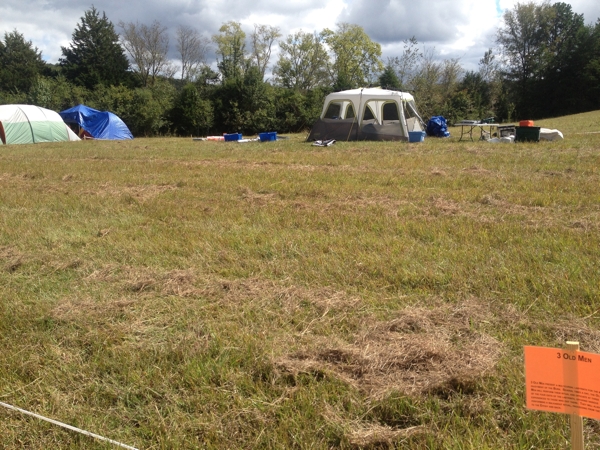
I had gone up the weekend before to help the Placement Team lay out the theme camp areas, so I knew what to expect (which was an area smaller than I had requested and which barely had room for all of us). First we set our tents up, and then we got to work on the labyrinth. You will recall that I spent many weeks sewing hundreds of yards of muslin to create the new walls for the labyrinth, and on the whole it looked good.
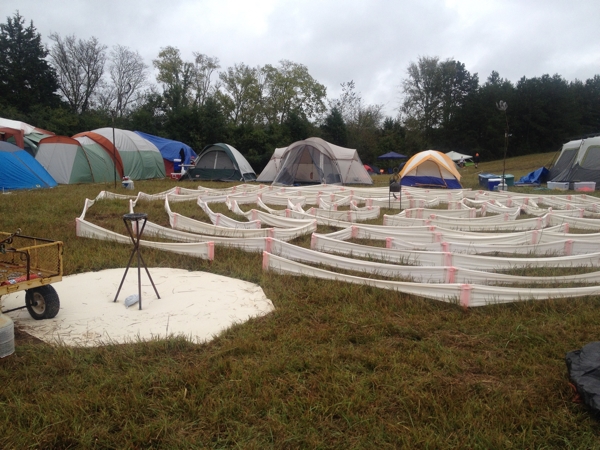
There were still some saggy spots due to some inexplicable errors in my measuring. Safety pins worked; I’ll pull it all out and fix it next April before we hit the road again. You will also notice in the photo above the octagonal mat at the north entrance, with the tripod holding the bowl of kaolin.
Here’s our first test of the new fire thingies—actually called “poofers” by those whose craft this is. It was very cool:
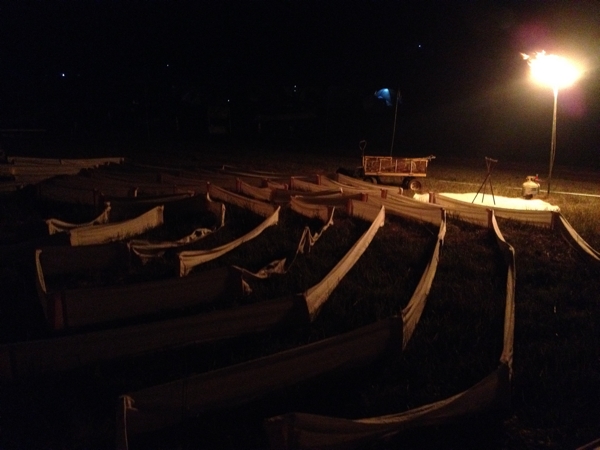
However, the weather was not in our favor. It was supposed to be pretty all weekend, with a high pressure area keeping a rain front at bay until we were done, but Hurricane Joaquin ruined all that. It began raining Wednesday night and did not stop until Sunday. The 3 Old Men generally do four of our labyrinth rituals a day, but at this burn we were barely able to do four altogether.
But boy, we looked great when we did:

It looks like we’re holding the flame, but we’re not. We’re holding our 8-foot staffs; the poofers were right behind us. Quite impressive.
For some reason, I own more tarps than necessary, but thank goodness for that. We were able to fashion a reasonably comfortable shelter from two of our canopies and the tarps. Here’s our kitchen/living room area. I bought a propane fire pit after last year’s experience of freezing half the time—you can see it back with the chairs. Everyone rejoiced that I had made the purchase:
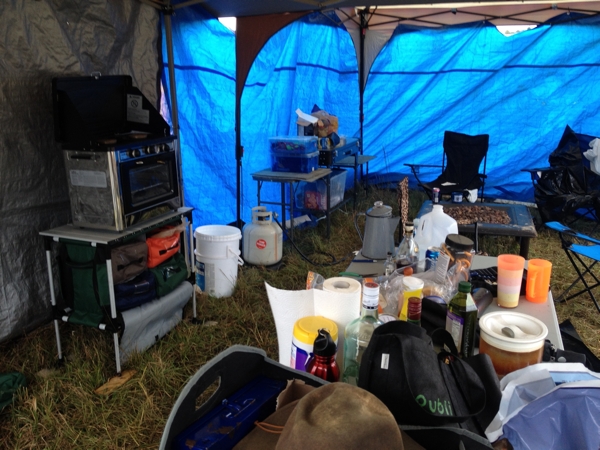
I joked that the number of new structures in our camp was deplorable. Passersby would have seen multiple Old Men poring over instructions while others helped assemble their tents and canopies. But we were not alone in that regard, I discovered as I walked about.
It rained. After so much planning and execution, it was very disappointing that everything you owned was wet and muddy. Dry socks became a commodity. The camps became mudpits; the parking lot and roads became impassable:

The leadership of the event prevented what could have been a catastrophe with speed and decisiveness. They closed the gates to keep the parking lot from trapping thousands of vehicles in the mud; had gravel brought in for the roads inside the burn itself; reopened the gates; provided shuttles to get people/stuff into (and out of) the burn; and in general leadership neither played nor slept for the four days of the burn.
This didn’t solve all the problems, of course. More than a few theme camps never made it, and several funded art projects were never installed. Those that did were severely hampered by the weather—a cuddle pit of stuffed animals, for example, becomes problematic when they’re all soaked. It was uncomfortable to travel, so many people didn’t get out and about as much as they normally would have. (My personal goal this burn was to get out and experience more of the burn. Because I’m a great wimp, I partially failed at that, although I did see more this year than last year.)
In our own camp, three members never made it, and three went home on Saturday afternoon during a break in the rain. Because the labyrinth was now a sopping wet, heavy mess, I asked my campmates to help me take it down while they were still there, which they kindly did.
After we got it all down, we found that despite the weather we had had enough visitors to trample the grass into the very recognizable outline of our labyrinth:
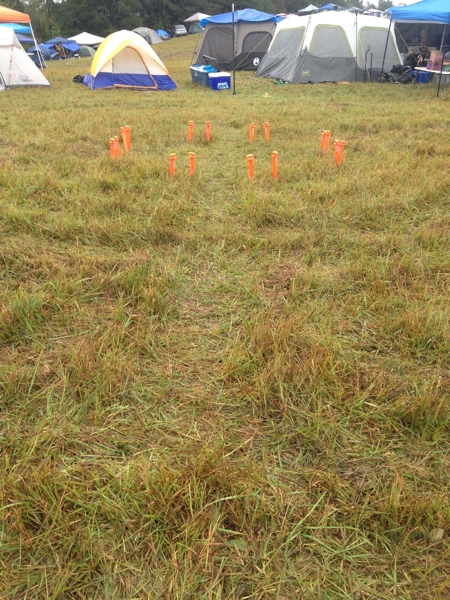
At that point we were grateful that the owner of the property had not mown our area again before we got there. The trampled grass prevented our camp from being a complete mud hole.
However, everything was still soaked to the core. I had put my tent where a depression ran through the campsite, and it became a river. One corner of my tent ended up below the water level, pulling a Titanic and letting water in over the rubberized flooring. Even after I shored up the corner and then mopped/bailed out the inside, it felt and sounded as if I were walking on a water bed, and after I took my tent down on Monday I discovered why:
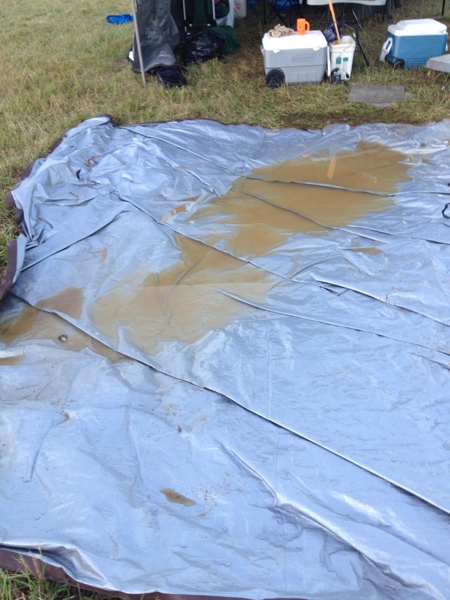
By Sunday afternoon when the rain finally stopped, the three of us remaining had all decided to stay until Monday to let the mud settle a bit and to see if there was less competition to get out of the parking lot. This proved to be the right decision, and without too much trouble I was able to load the trailer and cross the flooded “dry creek” to get back on the road to Newnan.
![]()
Here’s the thing: even though my mantra for the entire burn was “I can be cold, or I can be wet, but I cannot be cold and wet,” and nothing I owned would dry out, and half my camp either left early or didn’t arrive at all, and everything was just wet, wet, and gross, it was still a burn. It was still full of wonderful people doing amazing things. Art still went up, food and drink were still served, whomp-whomp music still played all night [I’m looking at you, Discordia…], and stuff was still burned.
For example, here’s the Minotaur, a 30-foot tall sculpture by Vermont artists Kim and Chris Cleary:
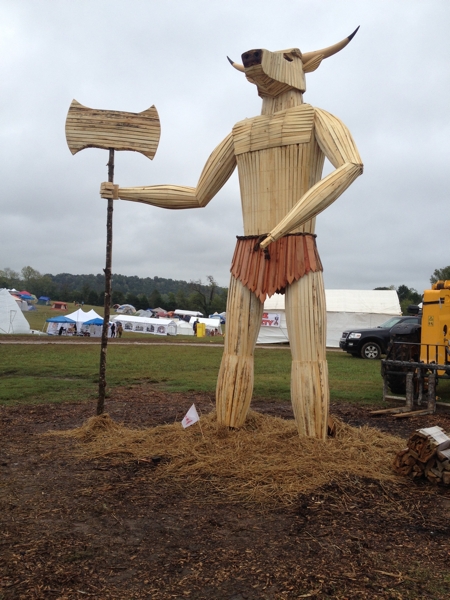
Here’s the Effigy itself, atop the hill:
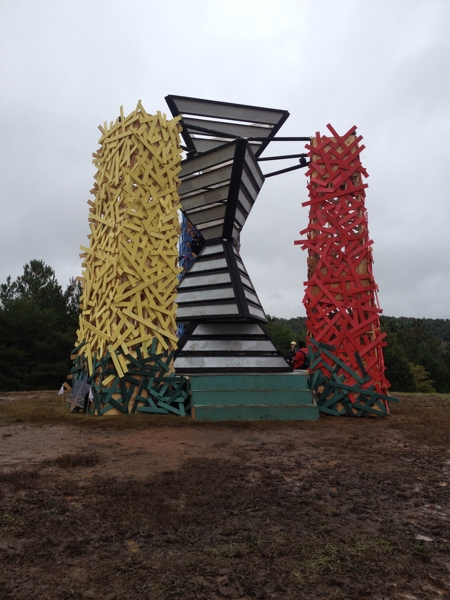
That thing was actually climbable. Hippies younger than I did that.
Here’s the Temple at night, lit from within:
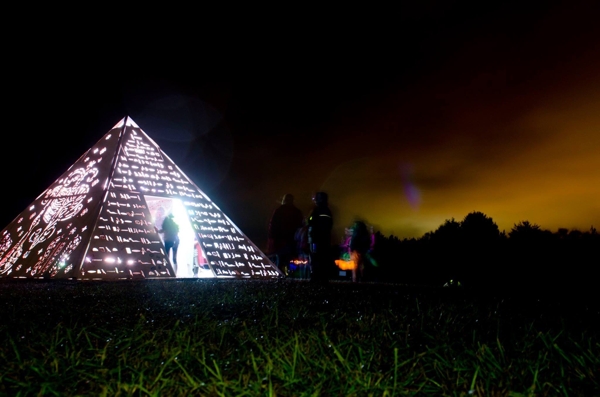
So much more, none of which I have photos of, and which I would be hard pressed to list or describe. There was a butterfly dome with scores of Monarch butterflies, all released the last day of the burn to find their way south. There were amazing sculptures of light, programmed to react to the presence and movement of the itinerant hippies. There were camps to dance in, to sing in, to eat and drink in, to take shelter in. There were thousands of muddy hippies, ruefully making the best of a terrible situation with good humor and sass; the burn was soon rechristened as “Alchemuddy: Almudgamation.”
Because of the Principle of Radical Self-Reliance, Alchemy never threatened to turn into a disaster like TomorrowWorld, which had stranded thousands of unprepared party-goers in similar muddy woods just the weekend before. (Someone who camped at Tomorrow World told me that for those who were burners, TomorrowWorld was fine. It was just the “sparkle ponies” who descended into chaos.)
Above all, there was that sense of community which sustains those of us who burn and which lures us back again and again:

That’s a shot of Center Camp—information stations, performance space, and art projects—from Effigy Hill. Does that look like a terrible place to be? It was not, rain or no.
Here’s another shot of the main camping area, taken from Silent Hill:
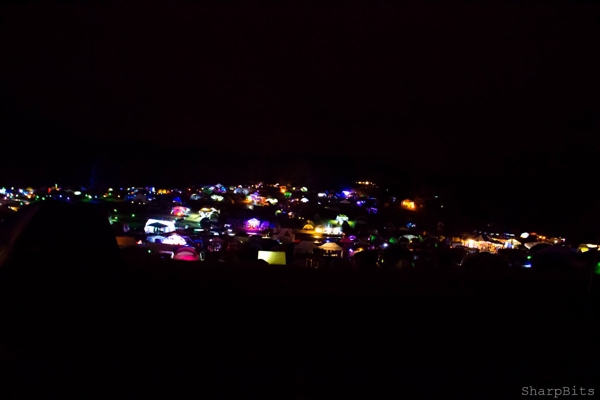
Behind this view is a hilltop covered with more camps, and out of sight to the right and to the far right are three more camping areas. You never run out of places to go and hippies to meet.
And did the rain stop the hippies from burning All The Things? It did not:
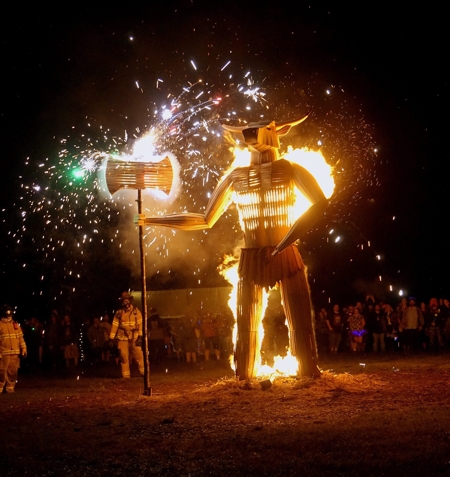
The Minotaur burned—the Effigy burned—the Temple burned. We cheered, we danced, we sat in silence. On Sunday, it was very strange to walk around the burn and be aware that the hill was empty: no Effigy, no Temple, all consumed, gone.
And Sunday was just fun. The burn officially goes through Monday morning, but many people leave on Sunday since they have to work on Monday. I of course do not have that problem, and now I plan to stay through Sunday night anyway. The rain had stopped and it was warmer. My fellow Old Men and I tromped all around the burn—all the large camps were in full swing, and we ended up at a sound camp deep in the woods, watching brilliant fire spinners do their thing and dancing to the DJs set.
So was it miserable? Absolutely. Would I do it again? Without any hesitation.
So here are two photos of Alchemy 2015:
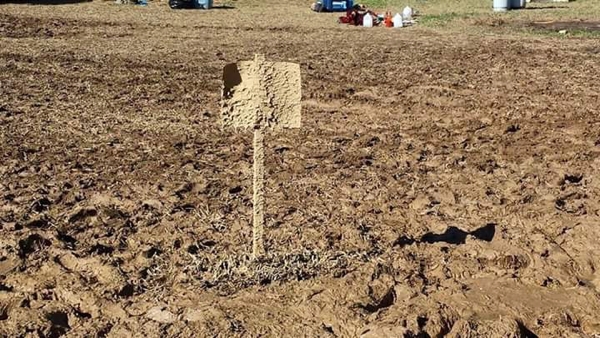
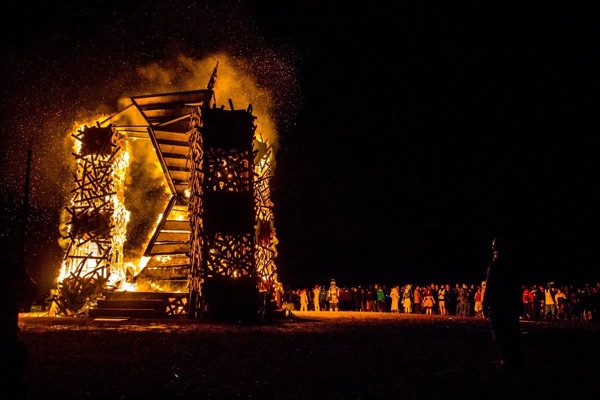
Both are true.
Back in the summer, a Kickstarter campaign came over the transom and I was intrigued enough to click on the link and learn more.
It was for this company, SoLight Design. They had a new design, the Solar Helix, that they wanted to bring to market, and they were crowdfunding that effort. The hook was that they also wanted to be able to send their original design, the SolarPuff, to the victims of the Haiti earthquake as a sustainable light source. Just as the campaign launched, Nepal was hit by its earthquake, and so the company added Nepal to the list. (They have since added Syria.)
Like most Kickstarter campaigns, there were different levels of donation, and for each level you received various numbers of SolarPuffs and Solar Helixes and some other number of SolarPuffs would be sent to Haiti/Nepal. I ordered the one Helix and two Puffs package; I don’t remember how many lights that donated.
The response was so overwhelming that the company missed all their donor shipping dates in order to manufacture and ship the donated lights to Haiti and Nepal. Somehow I was not annoyed by that.
Yesterday, my three lights came, finally, and all I can say is WOW!
Here’s the SolarPuff:
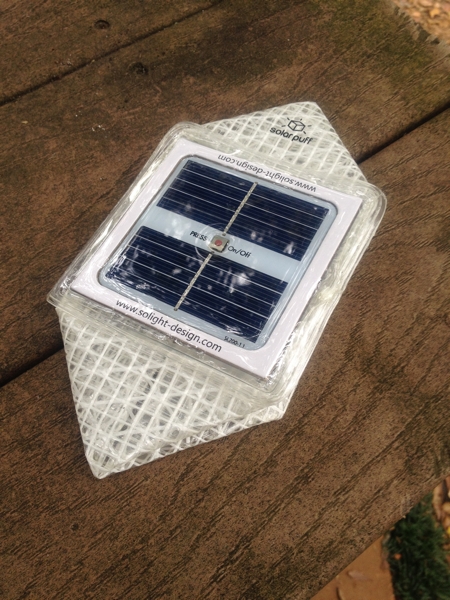
Here’s the Helix:
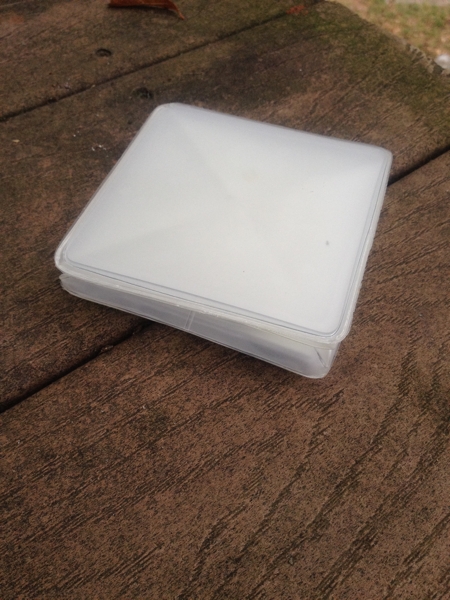
They both come in little ziplock bags, already charged. Both are these charming little origami packets.
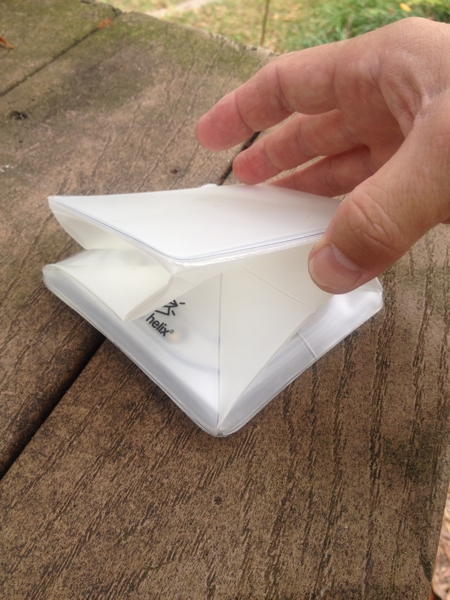
See? That’s the Helix in mid-opening. And here it is fully opened:
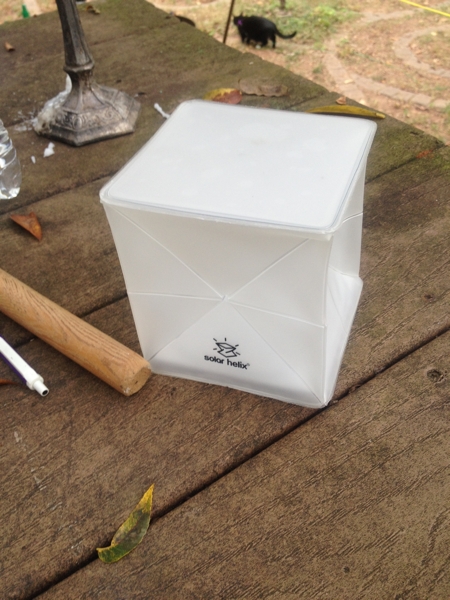
And lit:
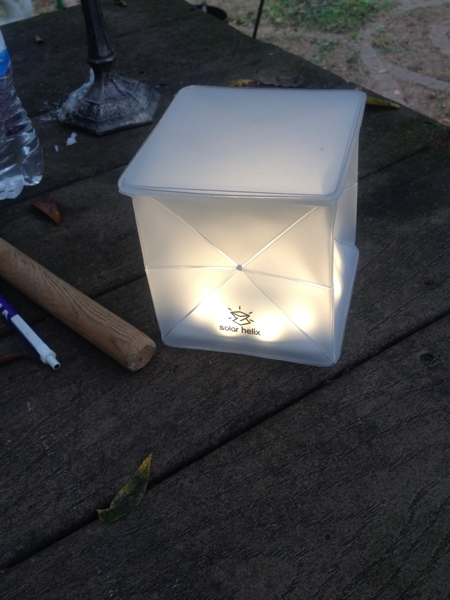
Here’s the Puff fully opened:
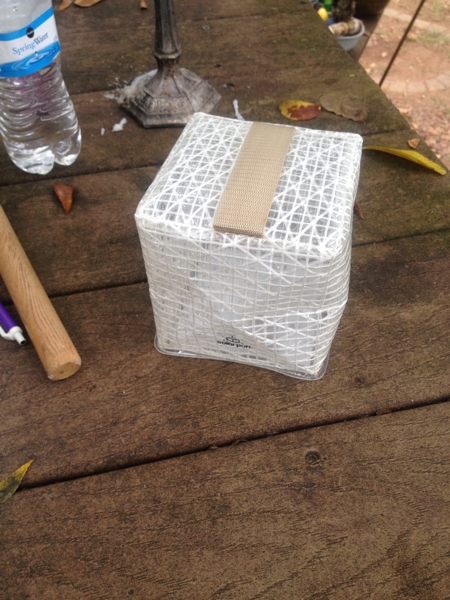
And lit:
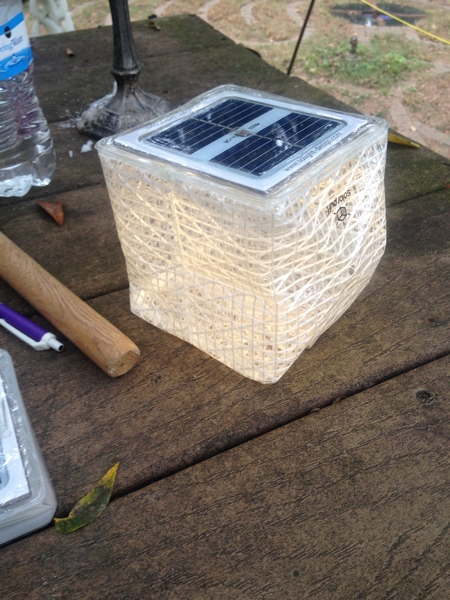
Both have three settings for the LED lights: regular, bright, and blinking. Both put out an amazing amount of light: last night in the labyrinth, one of them hanging out over the labyrinth lit the entire southern half of the pathway. No more stumbling about wondering where the lines are!
Both have straps/handles on one side for carrying or hanging. The light is warm, not that hideous cold blue that most LEDs are. Eight hours of charging will give you 8-12 hours of light.
Besides the different construction and materials, the Helix has its strap on the same side as the solar panel, while the Puff’s strap is on the opposite side. Both configurations would be useful in their own way, I guess. The Helix can hang and shed light from above; the Puff might be better suited sitting on a table—if you hang it, the solar panel blocks the bottom light, and in fact the light would be aimed upward.
But what incredible stuff! Lightweight, collapsible, sustainable, safe, and beautiful—they require no fuel but the sun, and there’s no danger of burning your house down or filling it with carbon monoxide. What an amazing gift to people in disaster areas! And for vaguely hippie-ish types like myself, what a cool, elegant way to light your various labyrinths, theme camps, or patios! I imagine caterers and party planners would snap these up.
I’m off to buy some more.
Well, poot, as my mother used to say:
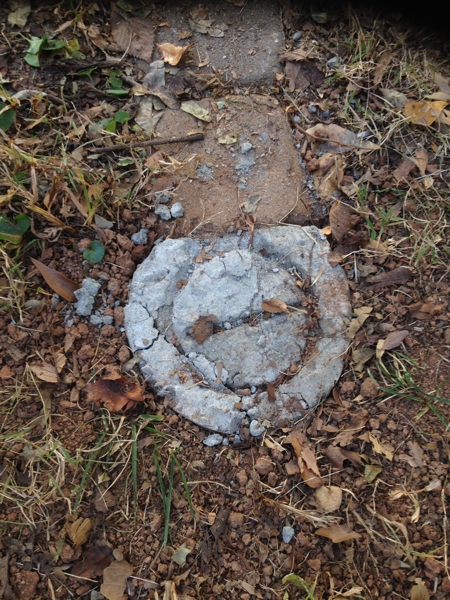
This is the water endstone. I made the mistake, the day of the pouring, of picking it up to remove the cardboard form. It crumbled. The others seem to be fine, so I’m left to wonder whether I added too much water to the bucket for this one or I just should have waited to disturb it.
Not a problem: I have 30 pounds of concrete mix left. I can make another one.
After months of procrastination planning, I finally got around to creating the new endpoints for the labyrinth.
Digging out the holes for the forms was easy. Next I mixed up the concrete—slightly nerve-wracking, since I’ve never done this before—and scooped the muck into them. I knew enough to shake the form a bit to get any air bubbles out, although truly the structural integrity of the bricks is not an issue.
After I got them poured and they set up for about an hour, I decided that I did want the alchemical symbols for the four classical elements engraved into them. I cast about for ways to do that and came up with a simple solution: a flower pot and a folded piece of cardboard.
So here we have…
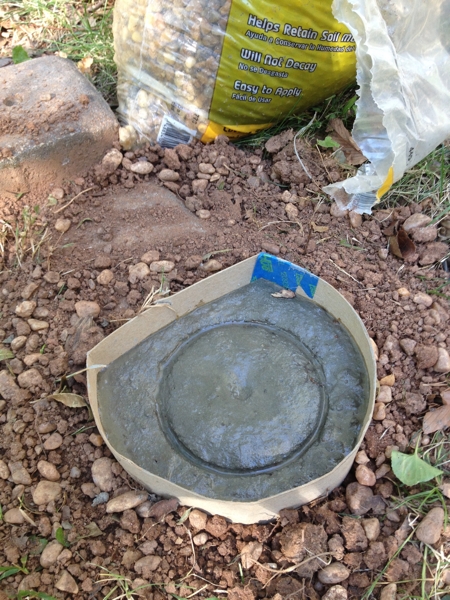
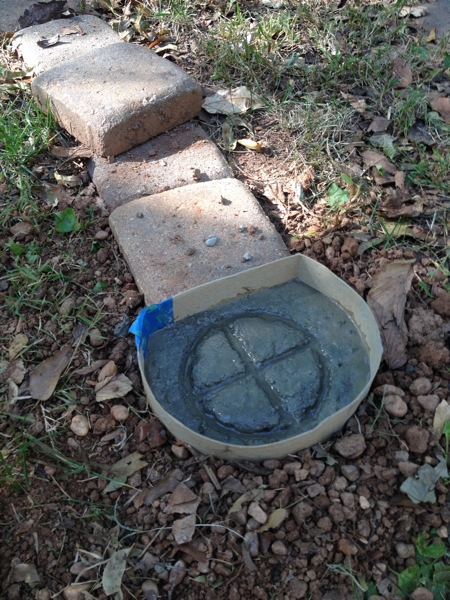
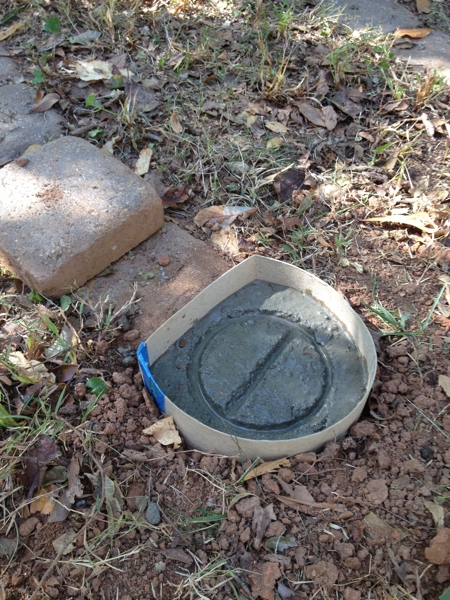
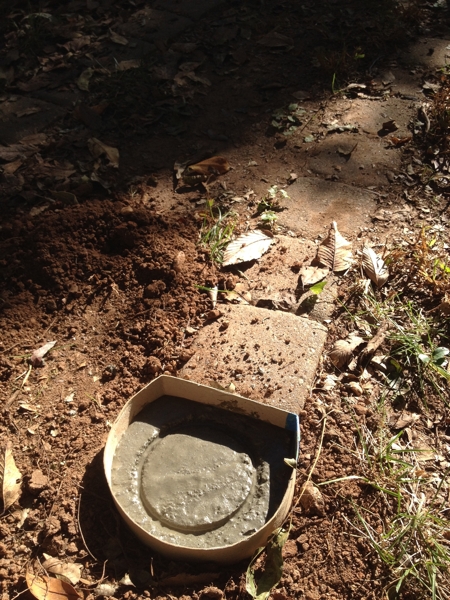
I realized that if this doesn’t work out—and there are some issues I may not be able to stand—I have half a bag of concrete mix still available.
(I had extra concrete this time, which I used to pour a small slab for the westpoint bowl’s stand to sit on. It had begun to list.)
In our ongoing study of contemporary Christianist martyrs, these two examples popped up on Facebook in the last 24 hours:

…and…

Both were accompanied by that quivering lip bravado to which these people seem to be addicted. They just know there are lions. There’ve got to be lions, coming to eat them, right? But they’re brave, standing up against their oppressors—i.e., Them. All of Them.
Neither the originators of the items nor the people in my feed who posted them—damn you, Facebook, for making the word “friends” a dicey proposition—nor any of the other posters betrayed the slightest self-awareness about these two items. Not even after I posted my comments, to wit:
::sigh::
Okay, I promise I’ll write more entertaining stuff in the near future. I was so wrapped up in getting ready for Alchemy, then surviving Alchemy—I told you it would be entertaining—and now getting ready for Christmas Carol auditions, that I didn’t even notice I hadn’t been blogging.